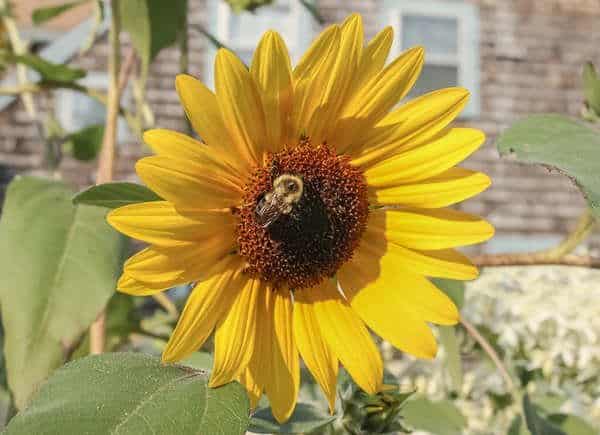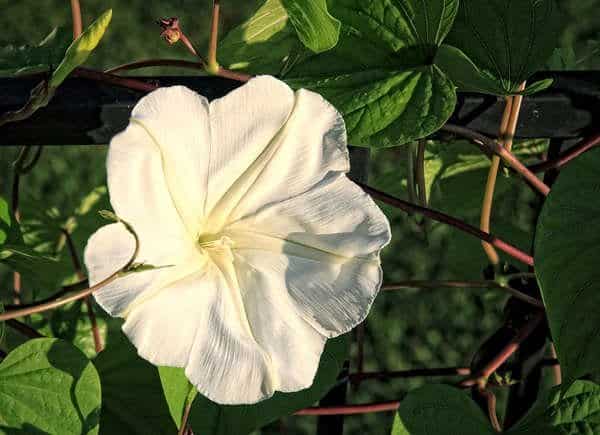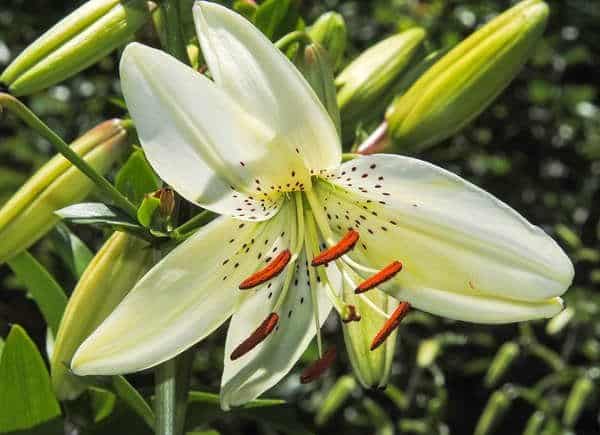Enthralling to garden enthusiasts and plant lovers alike, the spectacle of massive blooms captivates the eye and captures the imagination. Large flowering plants are not just visually impressive; they can serve as stunning focal points in a garden landscape, create striking contrasts, and even foster a greater biodiversity by attracting a variety of pollinators. There’s an undeniable appeal to growing such giants – an appeal rooted in the awe they inspire and the beauty they unfold. This post will navigate the world of these botanical wonders, providing insight into some of the largest flowering plants to consider for your garden.
Contents
Titan Sunflower

Standing tall with towering stalks, the Titan Sunflower is renowned for its gigantic, dinner plate-sized flower heads. These sun-worshiping plants can reach heights of 12 feet or more, making them a breathtaking sight in any landscape. Their sun-yellow petals and large dark centers serve as excellent sources of both nectar and pollen, attracting a host of beneficial insects.
Despite their colossal size, Titan Sunflowers are surprisingly easy to grow. They thrive in well-drained soil and require plenty of sunlight. Regular watering and occasional fertilization will ensure robust growth and the development of those huge flower heads that make them so spectacular.
‘Giant White’ Moonflower

The ‘Giant White’ Moonflower graces the night with its luminous, large white blooms. As dusk descends, these stunning flowers unfurl, releasing a sweet, captivating fragrance into the evening air. Their blooms, which can span up to 6 inches in diameter, give the plant its name, lighting up the garden much like the moon lights up the night sky.
Cultivating ‘Giant White’ Moonflowers calls for a specific set of conditions. These night bloomers prefer rich, well-draining soil, and while they tolerate partial shade, they bloom best under full sun exposure. They also require a supporting structure like a trellis or fence to climb on. If provided with these conditions, moonflowers will reward the gardener with a stunning display of nightly blooms.
Supernova Angel’s Trumpet

The Supernova Angel’s Trumpet captivates with its sheer size and exotic charm. With gigantic, pendulous flowers that can grow up to 20 inches long, this plant truly earns its celestial name. Its trumpet-shaped blooms, ranging in color from yellow to pink, emit a heavenly scent that is most pronounced in the evening, inviting a symphony of night pollinators.
Growing these ornamental beauties involves a certain level of dedication. They flourish in rich, well-drained soil with regular feeding to promote the growth of large blooms. While they prefer full sun to partial shade, protection from wind is crucial, given the size and weight of their flowers. Remember to prune them regularly to maintain plant health and shape, and with this care, the Supernova Angel’s Trumpet can be a show-stopping centerpiece in your garden.
Big Brother Lily

Big Brother Lily is an enchanting plant, boasting large, upward-facing flowers that can span up to 10 inches in diameter. These delightful blooms exude a sweet fragrance that lingers in the air, contributing an additional sensory appeal to their visual spectacle. This variant of Oriental lily displays a beautiful palette of cream and pink, which creates an enticing contrast against its lush green foliage.
These lilies are quite robust and adaptable, thriving in both full sun and partial shade. They prefer well-drained soil and, while they can tolerate a certain degree of dryness, they perform best with consistent moisture. Stake support might be necessary for these plants as their massive blooms can cause the stems to bend. Fertilizing them in spring can promote a more vigorous growth and spectacular blooms.
‘Moy Grande’ Hibiscus

‘Moy Grande’ Hibiscus is a perennial plant that offers some of the largest flowers in the hibiscus family. Its stunning blooms, which can reach a diameter of 12 inches, are a vibrant pink color that creates a visual feast for the eyes. These flowers are not just impressive in size; they also bloom continuously from early summer to the first frost, providing a long-lasting display of color and beauty.
Growing ‘Moy Grande’ Hibiscus calls for a sunny location with well-drained soil. These plants are relatively tolerant to various soil types, but they do appreciate consistent watering during dry periods. A balanced fertilizer applied in spring can boost their growth and flowering. Despite their tropical appearance, these hibiscus plants are quite hardy and can withstand cold temperatures, making them a fantastic choice for a wide range of climates.
Atlas Magnolia

Atlas Magnolia is a stunning tree that produces enormous, fragrant flowers. These creamy white blossoms can reach up to 14 inches in diameter, earning Atlas Magnolia its reputation as a giant among magnolias. The sheer size of its blooms, coupled with a robust fragrance, makes this plant a standout in any landscape, captivating both the eyes and the nose.
When it comes to cultivation, Atlas Magnolias are relatively low maintenance. They grow best in slightly acidic, well-draining soil and appreciate a sunny location with some afternoon shade. While they can tolerate short periods of drought once established, young trees will benefit from regular watering. An annual application of a balanced fertilizer will promote healthy growth and an abundance of large blooms. Providing these conditions will ensure that an Atlas Magnolia will thrive, rewarding the effort with a stunning display of giant flowers.
Big Daddy Hydrangea

Big Daddy Hydrangea, a fitting name for a plant that produces such voluminous flower heads, is a visual delight in any garden. Its massive clusters of blooms, which can reach a span of up to 14 inches, come in a range of colors depending on the soil’s acidity. Their stunning display, from late spring to fall, forms a striking contrast against the dark green, ovate leaves.
Caring for Big Daddy Hydrangeas involves providing them with rich, well-drained soil and consistent moisture. They thrive best in partial to full sun but appreciate some afternoon shade in hotter climates. It’s crucial to remember that their flower color, ranging from pink to blue, is determined by the soil pH – more acidic soils produce blue flowers, while alkaline conditions yield pink blooms. Pruning in late winter or early spring will help maintain a manageable size and promote a robust blooming season.
Fireworks Clematis

Fireworks Clematis truly lives up to its name with its large, vibrant, star-shaped blooms that resemble a stunning firework display. These flowers, which can span up to 8 inches in diameter, offer a gorgeous array of violet-blue petals with a striking pink stripe running down the center. Blooming from late spring to early summer, they provide a spectacular burst of color in the garden.
This flowering vine requires a little more attention compared to others on this list. It requires well-drained soil and prefers its roots to be in the shade while the rest of the plant is in the sun. Regular watering, especially in dry periods, is essential. This plant is also a climber, so providing it with adequate support like a trellis or fence is crucial. Regular pruning will maintain the health and shape of the plant and encourage the growth of those large, spectacular flowers.
Conclusion
Stepping into a garden adorned with large-blooming plants is an awe-inspiring experience – it’s a journey through a land of giants, where every blossom is a world of its own. From the towering Titan Sunflower to the gigantic ‘Giant White’ Moonflower, and from the colossal ‘Moy Grande’ Hibiscus to the vast Atlas Magnolia, these plants command attention, mesmerize with their size, and enthrall with their beauty. Encouraging such giants to flourish in a garden is not merely about creating a visually impressive landscape. It’s about embracing the grandeur of nature, creating a haven for biodiversity, and finding joy in the marvel of life’s most enchanting giants.